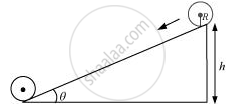Advertisements
Advertisements
प्रश्न
Prove the result that the velocity v of translation of a rolling body (like a ring, disc, cylinder or sphere) at the bottom of an inclined plane of a height h is given by `v^2 = (2gh)/((1+k^2"/"R^2))`.
Using dynamical consideration (i.e. by consideration of forces and torques). Note k is the radius of gyration of the body about its symmetry axis, and R is the radius of the body. The body starts from rest at the top of the plane.
उत्तर १
A body rolling on an inclined plane of height h is shown in the following figure:

m = Mass of the body
R = Radius of the body
K = Radius of gyration of the body
v = Translational velocity of the body
h =Height of the inclined plane
g = Acceleration due to gravity
Total energy at the top of the plane, E1= mgh
Total energy at the bottom of the plane, `E_b = KE_rot + KE_trans`
`=1/2 Iomega^2 + 1/2 mv^2`
But `I = mk^2 " and " omega = v/r`
`:.E_b = 1/2 (mk^2)(v^2/R_2) + 1/2 mv^2`
`=1/2 mv^2 k^2/R^2 + 1/2mv^2`
`= 1/2 mv^2(1+ k^2/R^2)`
From the law of conservation of energy, we have:
`E_T = E_b`
`mgh = 1/2mv^2(1+k^2/R^2)`
`:.v = (2gh)/(1+k^2"/"R^2)`
Hence, the given result is proved.
उत्तर २
Let a rolling body (I = Mk2) rolls down an inclined plane with an initial velocity u = 0; When it reaches the bottom of the inclined plane, let its linear velocity be v. Then from conservation of mechanical energy, we have Loss in P.E. = Gain in translational K.E. + Gain in rotational K.E.

`Mgh = 1/2mv^2 + 1/2 Iomega^2`
`= 1/2mv^2 + 1/2(mk^2)(v^2/R^2)`
`Mgh = 1/2mv^2 (1+k^2/R^2)`
`v^2 = (2gh)/(1+k^2/R^2)`
APPEARS IN
संबंधित प्रश्न
Read each statement below carefully, and state, with reasons, if it is true or false;
For perfect rolling motion, work done against friction is zero.
Read each statement below carefully, and state, with reasons, if it is true or false;
A wheel moving down a perfectly frictionless inclined plane will undergo slipping (not rolling) motion
A hollow sphere is released from the top of an inclined plane of inclination θ. (a) What should be the minimum coefficient of friction between the sphere and the plane to prevent sliding? (b) Find the kinetic energy of the ball as it moves down a length l on the incline if the friction coefficient is half the value calculated in part (a).
A pendulum consisting of a massless string of length 20 cm and a tiny bob of mass 100 g is set up as a conical pendulum. Its bob now performs 75 rpm. Calculate kinetic energy and increase in the gravitational potential energy of the bob. (Use π2 = 10)
A disc of the moment of inertia Ia is rotating in a horizontal plane about its symmetry axis with a constant angular speed ω. Another disc initially at rest of moment of inertia Ib is dropped coaxially onto the rotating disc. Then, both the discs rotate with the same constant angular speed. The loss of kinetic energy due to friction in this process is, ______
What is the difference between sliding and slipping?
A uniform disc of mass 100g has a diameter of 10 cm. Calculate the total energy of the disc when rolling along with a horizontal table with a velocity of 20 cms-1. (take the surface of the table as reference)
A solid sphere rolls down from top of inclined plane, 7m high, without slipping. Its linear speed at the foot of plane is ______. (g = 10 m/s2)
A ring and a disc roll on horizontal surface without slipping with same linear velocity. If both have same mass and total kinetic energy of the ring is 4 J then total kinetic energy of the disc is ______.
When a sphere rolls without slipping, the ratio of its kinetic energy of translation to its total kinetic energy is ______.
